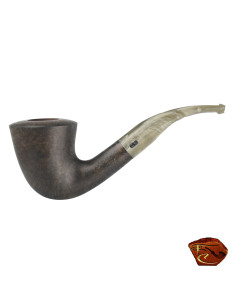Calabash shape pipes
The term "Calabash" comes from the calabash gourd in which these first pipes were made in the 17th century. The calabash system consists of a cooling chamber which is located under the bowl or possibly in the shank: in this last case one calls it "reverse calabash". The Calabash shape designates a pipe whose bowl is conical with possibly more or less pronounced edges on its top part.
The Calabash Pipe: An Iconic Shape That Has Become Rare
With its instantly recognizable downward curve, the Calabash pipe has established itself as one of the most iconic designs in the history of pipe smoking. While traditional models — crafted from natural gourd and topped with a meerschaum bowl — have become rare and artisanal, the Calabash shape continues to inspire many contemporary creations.
Today, it is often made from briar wood and carved as a single-piece pipe. Though these modern interpretations differ from the original construction, they retain a strong visual identity. Whether faithful to tradition or simply inspired by its elegant curves, the Calabash remains a favored reference among enthusiasts for its comfortable grip, smooth draw, and distinctive aesthetic.
A Historical Design, Engineered for Comfort
The traditional Calabash stands out with its unique construction: a hollow body made from dried and shaped gourd, topped with a meerschaum bowl. This architecture creates a natural condensation chamber between the bowl and the stem, allowing the smoke to cool and dry before reaching the mouth.
This ingenious system delivers a cool, dry, and smooth smoke, making the Calabash a preferred choice for those who appreciate natural or complex tobacco blends.
Modern Variants: Inspired but Distinct
Today, genuine Calabash pipes made from natural gourd are rare and crafted by hand, requiring years of drying for the gourd and careful fitting of the bowl. Produced in limited quantities, these pieces are sought after by seasoned collectors.
At the same time, many manufacturers offer Calabash-shaped pipes carved directly from a block of briar. These versions do not reproduce the internal condensation chamber but retain the generous and downward-curved shape that defines the style. Often referred to as Calabash-form pipes, they provide a comfortable feel in hand and well-balanced smoking experience, while acknowledging their distinction from the traditional technical design.






